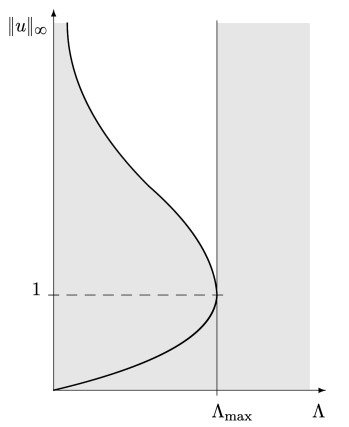|
[1]
|
B. Abdellaoui, I. Peral, Existence and nonexistence results for quasilinear elliptic equations involving the p-Laplacian with a critical potential, Ann. Mat. Pura Appl. IV. Ser., 182 (2003), 247–270. https://doi.org/10.1007/s10231-002-0064-y doi: 10.1007/s10231-002-0064-y

|
|
[2]
|
A. Anane, J. L. Lions, Simplicitè et isolation de la premiere valeur propre du p-laplacien avec poids, C. R. Acad. Sci. Paris Sér. I Math., 305 (1987), 725–728.
|
|
[3]
|
T. Bhattacharya, E. DiBenedetto, J. Manfredi, Limit as p→∞ of Δpup=f and related extremal problems, Rend. Sem. Mat. Univ. Politec. Torino, 1989, 15–68.
|
|
[4]
|
M. Bocea, M. Mihǎilescu, Existence of nonnegative viscosity solutions for a class of problems involving the ∞-Laplacian, Nonlinear Differ. Equ. Appl., 23 (2016), 11. https://doi.org/10.1007/s00030-016-0373-2 doi: 10.1007/s00030-016-0373-2

|
|
[5]
|
G. Bratu, Sur les équations intégrales non linéaires, Bulletin de la S. M. F., 42 (1914), 113–142.
|
|
[6]
|
H. Brezis, L. Oswald, Remarks on sublinear elliptic equations, Nonlinear Anal. Theor., 10 (1986), 55–64. https://doi.org/10.1016/0362-546X(86)90011-8 doi: 10.1016/0362-546X(86)90011-8

|
|
[7]
|
X. Cabré, M. Sanchón, Semi-stable and extremal solutions of reaction equations involving the p-Laplacian, Commun. Pure Appl. Anal., 6 (2007), 43–67. https://doi.org/10.3934/cpaa.2007.6.43 doi: 10.3934/cpaa.2007.6.43

|
|
[8]
|
S. Chandrasekhar, An introduction to the study of stellar structures, New York: Dover, 1957.
|
|
[9]
|
S. Chanillo, M. Kiessling, Surfaces with prescribed Gauss curvature, Duke Math. J., 105 (2000), 309–353. https://doi.org/10.1215/S0012-7094-00-10525-X doi: 10.1215/S0012-7094-00-10525-X

|
|
[10]
|
F. Charro, E. Parini, Limits as p→∞ of p-laplacian problems with a superdiffusive power-type nonlinearity: positive and sign-changing solutions, J. Math. Anal. Appl., 372 (2010), 629–644. https://doi.org/10.1016/j.jmaa.2010.07.005 doi: 10.1016/j.jmaa.2010.07.005

|
|
[11]
|
F. Charro, E. Parini, Limits as p→∞ of p-laplacian eigenvalue problems perturbed with a concave or convex term, Calc. Var., 46 (2013), 403–425. https://doi.org/10.1007/s00526-011-0487-7 doi: 10.1007/s00526-011-0487-7

|
|
[12]
|
F. Charro, I. Peral, Limit branch of solutions as p→∞ for a family of sub-diffusive problems related to the p-laplacian, Commun. Part. Diff. Eq., 32 (2007), 1965–1981. https://doi.org/10.1080/03605300701454792 doi: 10.1080/03605300701454792

|
|
[13]
|
F. Charro, I. Peral, Limits as p→∞ of p-Laplacian concave-convex problems, Nonlinear Anal. Theor., 75 (2012), 2637–2659. https://doi.org/10.1016/j.na.2011.11.009 doi: 10.1016/j.na.2011.11.009

|
|
[14]
|
M. G. Crandall, H. Ishii, P. L. Lions, User's guide to viscosity solutions of second order partial differential equations, Bull. Amer. Math. Soc., 27 (1992), 1–67. https://doi.org/10.1090/S0273-0979-1992-00266-5 doi: 10.1090/S0273-0979-1992-00266-5

|
|
[15]
|
J. Dávila, Singular solutions of semi-linear elliptic problems, In: Handbook of differential equations: stationary partial differential equations, Amsterdam: Elsevier/North-Holland, 2008, 83–176. https://doi.org/10.1016/S1874-5733(08)80019-8
|
|
[16]
|
M. Del Pino, J. Dolbeault, M. Musso, Multiple bubbling for the exponential nonlinearity in the slightly supercritical case, Commun. Pure Appl. Anal., 5 (2006), 463–482. https://doi.org/10.3934/cpaa.2006.5.463 doi: 10.3934/cpaa.2006.5.463

|
|
[17]
|
R. Emden, Gaskugeln: Anwendungen der mechanischen Wärmetheorie auf kosmologische und meteorologische Probleme (German), Germany: B. G. Teubner, 1907.
|
|
[18]
|
N. Fukagai, M. Ito, K. Narukawa, Limit as p→∞ of p-Laplace eigenvalue problems and L∞-inequality of the Poincare type, Differ. Integral Equ., 12 (1999), 183–206.
|
|
[19]
|
J. P. García Azorero, I. Peral, Existence and nonuniqueness for the p-laplacian: nonlinear eigenvalues, Commun. Part. Diff. Eq., 12 (1987), 1389–1430.
|
|
[20]
|
J. García Azorero, I. Peral Alonso, On a Emden-Fowler type equation, Nonlinear Anal. Theor., 18 (1992), 1085–1097. https://doi.org/10.1016/0362-546X(92)90197-M doi: 10.1016/0362-546X(92)90197-M

|
|
[21]
|
J. García Azorero, I. Peral Alonso, J. P. Puel, Quasilinear problems with exponential growth in the reaction term, Nonlinear Anal. Theor., 22 (1994), 481–498. https://doi.org/10.1016/0362-546X(94)90169-4 doi: 10.1016/0362-546X(94)90169-4

|
|
[22]
|
I. M. Gel'fand, Some problems in the theory of quasilinear equations, Amer. Math. Soc. Trans., 29 (1963), 295–381.
|
|
[23]
|
J.-F. Grosjean, p-Laplace operator and diameter of manifolds, Ann. Glob. Anal. Geom., 28 (2005), 257–270. https://doi.org/10.1007/s10455-005-6637-4 doi: 10.1007/s10455-005-6637-4

|
|
[24]
|
J. Jacobsen, K. Schmitt, The Liouville-Bratu-Gelfand problem for radial operators, J. Differ. Equations, 184 (2002), 283–298. https://doi.org/10.1006/jdeq.2001.4151 doi: 10.1006/jdeq.2001.4151

|
|
[25]
|
R. Jensen, Uniqueness of Lipschitz extensions: Minimizing the sup norm of the gradient, Arch. Rational Mech. Anal., 123 (1993), 51–74. https://doi.org/10.1007/BF00386368 doi: 10.1007/BF00386368

|
|
[26]
|
D. D. Joseph, T. S. Lundgren, Quasilinear Dirichlet problems driven by positive sources, Arch. Rational Mech. Anal., 49 (1973), 241–269. https://doi.org/10.1007/BF00250508 doi: 10.1007/BF00250508

|
|
[27]
|
P. Juutinen, Minimization problems for Lipschitz functions via viscosity solutions, Helsinki: Suomalainen Tiedeakatemia, 1998.
|
|
[28]
|
P. Juutinen, Principal eigenvalue of a badly degenerate operator, J. Differ. Equations, 236 (2007), 532–550. https://doi.org/10.1016/j.jde.2007.01.020 doi: 10.1016/j.jde.2007.01.020

|
|
[29]
|
P. Juutinen, P. Lindqvist, On the higher eigenvalues for the ∞-eigenvalue problem, Calc. Var., 23 (2005), 169–192. https://doi.org/10.1007/s00526-004-0295-4 doi: 10.1007/s00526-004-0295-4

|
|
[30]
|
P. Juutinen, P. Lindqvist, J. Manfredi, The ∞-eigenvalue problem, Arch. Rational Mech. Anal., 148 (1999), 89–105. https://doi.org/10.1007/s002050050157 doi: 10.1007/s002050050157

|
|
[31]
|
B. Kawohl, On a family of torsional creep problems, J. Reine Angew. Math., 410 (1990), 1–22.
|
|
[32]
|
P. Lindqvist, On the equation div(|∇u|p−2∇u)+λ|u|p−2u=0, Proc. Amer. Math. Soc., 109 (1990), 157–164. https://doi.org/10.1090/S0002-9939-1990-1007505-7 doi: 10.1090/S0002-9939-1990-1007505-7

|
|
[33]
|
P. Lindqvist, Addendum: "On the equation div(|∇u|p−2∇u)+λ|u|p−2u=0'' [Proc. Amer. Math. Soc. 109 (1990), no. 1,157–164; MR1007505 (90h: 35088)], Proc. Amer. Math. Soc., 116 (1992), 583–584. https://doi.org/10.1090/S0002-9939-1992-1139483-6
|
|
[34]
|
P. Lindqvist, J. Manfredi, The Harnack inequality for ∞-harmonic functions, Electron. J. Diff. Eqns., 5 (1995), 1–5.
|
|
[35]
|
P. Lindqvist, J. Manfredi, Note on ∞-superharmonic functions, Revista Matemática de la Universidad Complutense de Madrid, 10 (1997), 471–480.
|
|
[36]
|
P. L. Lions, On the existence of positive solutions of semilinear elliptic equations, SIAM Rev., 24 (1982), 441–467. https://doi.org/10.1137/1024101 doi: 10.1137/1024101

|
|
[37]
|
J. Liouville, Sur l'équation aux différences partielles d2logλdudv±λ2a2=0, Journal de mathématiques pures et appliquées 1re série, 18 (1853), 71–72.
|
|
[38]
|
M. Mihǎilescu, D. Stancu-Dumitru, C. Varga, The convergence of nonnegative solutions for the family of problems −Δpu=λeu as p→∞, ESAIM: COCV, 24 (2018), 569–578. https://doi.org/10.1051/cocv/2017048 doi: 10.1051/cocv/2017048

|
|
[39]
|
I. Peral, Some results on quasilinear elliptic equations: growth versus shape, In: Proceedings of the second school of nonlinear functional analysis and applications to differential equations, Trieste: World Scientific, 1998,153–202.
|
|
[40]
|
O. W. Richardson, The emission of electricity from hot Bodies, India: Longmans, Green and Company, 1921.
|
|
[41]
|
M. Sanchón, Regularity of the extremal solution of some nonlinear elliptic problems involving the p-Laplacian, Potential Anal., 27 (2007), 217–224. https://doi.org/10.1007/s11118-007-9053-5 doi: 10.1007/s11118-007-9053-5

|
|
[42]
|
G. W. Walker, Some problems illustrating the forms of nebulae, Proc. R. Soc. Lond. A, 91 (1915), 410–420. https://doi.org/10.1098/rspa.1915.0032 doi: 10.1098/rspa.1915.0032

|
|
[43]
|
Y. Yu, Some properties of the ground states of the infinity Laplacian, Indiana Univ. Math. J., 56 (2007), 947–964.
|














 DownLoad:
DownLoad: